![]() September 2000
September 2000

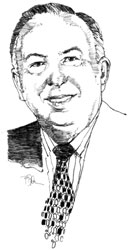 Illustration by Bart Forbes |
I feel that everything we've done has been right. The critical issues we
chose were the right ones for Scouting.
|
Not long after being named Chief Scout Executive, Jere Ratcliffe paid a visit to the place where Scouting got its start. Surveying the cold, deserted December landscape of Brownsea Island, Ratcliffe says, he was struck by the weight of what began there.
"You couldn't help but think about how far this idea of Scouting has gone. It has affected hundreds of millions of people, yet the concept was so simple. Because of its mission and vision, it has become the strongest youth movement in the free world."
As Chief Scout Executive of the Boy Scouts of America, Jere Ratcliffe has played a large part in shaping that vision. As only the ninth Chief Scout Executive in the organization's 90-year history, Jere Ratcliffe has overseen a period of historic growth and improvement. Through his vision and leadership, his administration has taken measured steps to strengthen every aspect of the organization, from membership to finance.
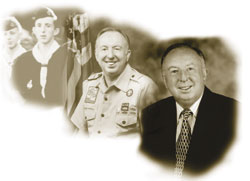
On March 27, 1993, one month after being named Chief Scout Executive, Ratcliffe went on the air with a satellite broadcast beamed to Scouting professionals across the country. It was his first opportunity to share his vision and set a direction for the organization.
Having served as a Scout executive for 17 years, he understood that councils already had plenty to deal with, and he was determined not to load them down with more. Rather, he wanted to identify and focus on a few issues that were critical to the long-term success of the Boy Scouts of America, primarily the changing demographics of the nation, growing traditional Scouting units, and finance.
Before becoming Chief Scout Executive, Ratcliffe had made his greatest mark in the area of fund-raising and endowment. Today, seven years later, his leadership in this area is considered by many to be his greatest legacy.
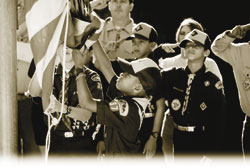 Innovative campaigns such as Operation Tiger Mania and the recent Garfield Round Up fueled tremendous growth in Cub Scouting, expanding the program by more than 5 percent to 2,181,013 members at the end of 1999. |
"I've always felt that endowment was what councils needed to have a dependable source of income," Ratcliffe says. "With an endowment, if there is a downturn in the economy, a council will continue to have a stable source of funding."
To spur growth in this critical area, Ratcliffe initiated the Nationally Coordinated Endowment Emphasis, an aggressive campaign designed to focus attention on endowment and to increase the level of endowment giving to local councils.
Growth of local council endowment was also fostered through the James E. West Fellowship, the 1910 Society, and the Founders Circle, which provide recognition for those who make significant contributions. Legal counsels were also added to each region to help local councils with endowment issues, while events such as the National Endowment Art Tour, national endowment teleconferences, and other programs helped generate interest in endowment giving.
The results of these efforts have been nothing short of fantastic. Since 1993, the level of endowment giving to local councils has more than doubled, and as a result, local council finances are in better condition than ever before.
"We had gone 85 years and raised $300 million for local council endowment. Today, the total value of gifts-in-hand and planned gifts is about $2.2 billion. And we've just scratched the surface," Ratcliffe says.
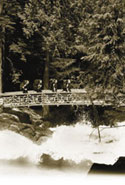 |
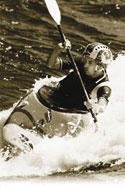 |
| We had gone 85 years and raised $300 million for local council endowment. Today, the total value of gifts-in-hand and planned gifts is about $2.2 billion. And we've just scratched the surface. | |
The emphasis on finance has gone far beyond endowment. Tremendous effort has been put into improving financial management at all levels of the organization, including "right-sizing" of personnel, and streamlining local council operations by reducing the number of council offices from 381 in 1993 to 314 at the end of 1999.
These efforts have allowed the National Council to redirect funds for use in other areas, including much-needed improvements to the high-adventure bases. In fact, since 1993, more than $1.5 million has been allocated each year for new construction and improvements at the bases. Projects include construction of staff housing and of warehousing at the Northern Tier High Adventure Base; the addition of an administration center, a welcome center, and a 100-person classroom at Philmont Scout Ranch; and an administrative building, Scout dormitory, and the new Briton Environmental Centre, currently under construction, at the Florida National High Adventure Sea Base.
 |
 |
 |
| The 11th edition of the Boy Scout Handbook, introduced in 1998, received rave reviews with its exciting graphics and updated content designed to appeal to today's youth. Cub Scouting has revised its Bear, Wolf, and Webelos books in the past two years, and Venturing brought out its new Venturer Handbook early this year. |  | |
 | ||
For decades, the demographics of America have been changing. Hispanics, Asians, and African Americans are now among the fastest growing segments of the U.S. population. Unfortunately, at-risk youth in many of these communities have been underserved by the Scouting movement.
Upon taking office, Ratcliffe's administration quickly turned its attention to providing greater service to at-risk youth by launching Operation First Class—later to become known as Scoutreach.
Scoutreach works with councils with large minority populations to provide training and develop the resources necessary to serve at-risk youth in urban and rural areas.
Of his administration's accomplishments, Ratcliffe counts Scoutreach as one of those he is most proud of. Challenges still exist in serving these communities, but thanks to his vision and the efforts of the Scoutreach Division, Scouting is delivering the promise of Scouting to kids who need it most.
|
More than 269,079 Scouts have achieved the rank of Eagle Scout since the beginning of 1993.
|
It stands to reason that if the Boy Scouts of America intended to serve more youth, additional Scouting units would have to be created for them to join.
"So we put the emphasis on expanding the number of units to be able to serve more youth," Ratcliffe says.
The effort has paid off with a 3.5 percent increase in traditional units since 1997. In 1999 alone, the number of new units increased by 1.7 percent. Not only has there been an increase in the number of units created, there has also been a decrease in the number of dropped units.
"We have had great success in this area," Ratcliffe says. "Give the credit to councils who have placed emphasis on commissioner service to improve service to units."
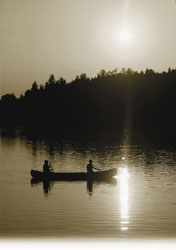 Launched in 1998, Venturing provides young men and women ages 14 to 20 the opportunity to participate in high-adventure activities. In its first full year of operation, Venturing's membership grew to 202,486, an increase of 7.7 percent. |
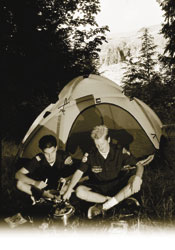 Emphasis on traditional unit growth has paid off with a 3.5 percent increase in traditional units since 1997. There has also been a decrease in the number of dropped units. |
For Ratcliffe, one of the best parts of working in the field was the opportunity to identify and develop leaders. He has carried that same dedication to leadership into his role as Chief Scout Executive. The inclusion of leadership as a critical issue in the 1998-2002 Strategic Plan reflects this commitment.
When asked what role unit-serving executives play in the future of Scouting, Ratcliffe doesn't hesitate, "They are the future." Unit-serving executives are the key to developing new units and to keeping existing units healthy, Ratcliffe says.
Since 1993, the number of unit-serving executives has increased by 20 percent to 2,405 at the end of 1999.
But the emphasis on leadership also includes volunteers.
"If I had to say one thing was more critical to our success than anything else, it would be quality of the local council board and the strength of district operations," Ratcliffe says.
How important has this emphasis on leadership been to the Boy Scouts of America? The numbers tell the story.
Today, boys are staying in Scouting longer. As a result, for the first time in memory, retention has fueled Scouting's membership growth. The number of traditional Scouting units is up, and the number of Cub Scouts participating in outdoor activities is up, as is attendance at Boy Scout camps. In 1999, 47,582 young men earned the rank of Eagle Scout, an increase of 7,000 from 1998, an all-time high.
Growing interest in character education in statehouses across the nation reflects the growing importance of Learning for Life. Many legislatures, most notably Florida's, are allocating money to fund character education in schools.
Such developments, along with strong support from the Learning for Life Division, has contributed to this program's phenomenal growth—more than 36.3 percent since 1993; 12.5 percent growth in 1999 alone. Today, Learning for Life is used by more than 21,000 organizations serving 1.5 million young people.
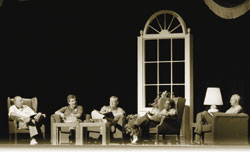 The 1998 National Leadership Training Conference, held in Nashville, Tennessee, brought Scouting's entire professional family together for the first time in 30 years to exchange ideas and discuss ways to strengthen Scouting. |
One of the most defining elements of the Ratcliffe administration has been the use of marketing research. Detailed studies have been conducted to evaluate and strengthen many of Scouting's programs, to develop new and more effective marketing tools, and to aid local council fund-raising and recruiting.
Landmark studies such as The Values of Men and Boys in America and A Year in the Life of a Cub Scout, both conducted for the BSA by Louis Harris and Associates, proved what many have known for decades: Scouting has a positive effect on the lives of young people.
"We had always known a lot about outcomes, but through quality research, we've been able to better define how we can reach out to our publics. It's told us a lot about the people we want to serve and what the results of service have been," Ratcliffe says.
Over the years, the Boy Scouts of America has fought to defend its constitutional right to maintain its standards of membership. A side effect of this battle has been a glut of negative publicity.
When Ratcliffe took office in 1993, he decided it was once again time to promote Scouting's value and its values.
"We decided that we had to stress the positive things that go on in Scouting every day."
Today, local councils share examples of their character-building work more than 2,400 times each month through their local media. The efforts have paid off not only in goodwill, but also in increased awareness, increased volunteerism, and improved financial support.
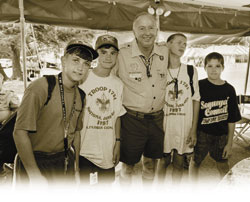 Since 1993, Ratcliffe has presided over two national Scout jamborees with combined youth and volunteer attendance of more than 70,464; he has led delegations at two world jamborees with Scouts representing 119 countries. |
Since taking office, Ratcliffe has traveled almost constantly—an average of 260 days per year—visiting councils and organizations on behalf of Scouting. But his efforts haven't stopped at the water's edge.
The list of countries he has visited on the behalf of World Scouting reads like an index from National Geographic: Guatemala, Guam, Peru, Poland, and the Czech Republic, to name just a few. Twice, he has been to the Republic of China to meet with its ministry of education. As the leader of the world's largest Scouting organization, his attendance at World Scout Conferences in Bangkok, Thailand, in 1993, Oslo, Norway, in 1996, and Durban, South Africa, in 1999, underlines the BSA's commitment to the growth of Scouting around the world.
"One of the things we offer to do when we go to one of these countries is to bring some of their professionals here to our training center. Rather than send someone over there to work their units, we bring them over here to teach them how to do it," Ratcliffe says. "It's the old idea of teaching people to fish."
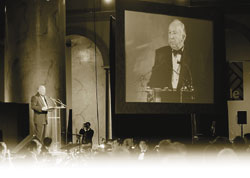 On February 8, 2000, more than 800 Scouting supporters from around the nation converged on the National Building Museum in Washington, D.C., to mark the 90th anniversary of the Boy Scouts of America. Attendees included community and business leaders as well as members of Congress. |
Looking back on his years at the helm of the world's largest youth-serving organization, Ratcliffe says he his proud of his administration's accomplishments, although he says most of the credit should go to the volunteers and professionals who participated in strategic planning for the organization and acted on the vision.
"If you've got a good game plan and you follow that game plan, you win. I feel that everything we've done has been right. The critical issues we chose were the right ones for Scouting.
"The important thing is that today, we, ourselves, have a very positive, upbeat feeling about Scouting, and I think our publics do, too."
Thanks to Ratcliffe's vision and to strong leadership provided by volunteers and professionals, Scouting is strong today. Local council finances are in better shape than ever, the number of traditional units is increasing, and membership is on the rise.
Most important of all, Scouting is continuing to reach out to young people who need it the most. "Scouting is needed more today than when it actually began," Ratcliffe says.
That fact alone is testament to the vision of a simple idea called Scouting that began all those years ago back on Brownsea Island.
| The Boy Scouts of America | http://www.scouting.org |